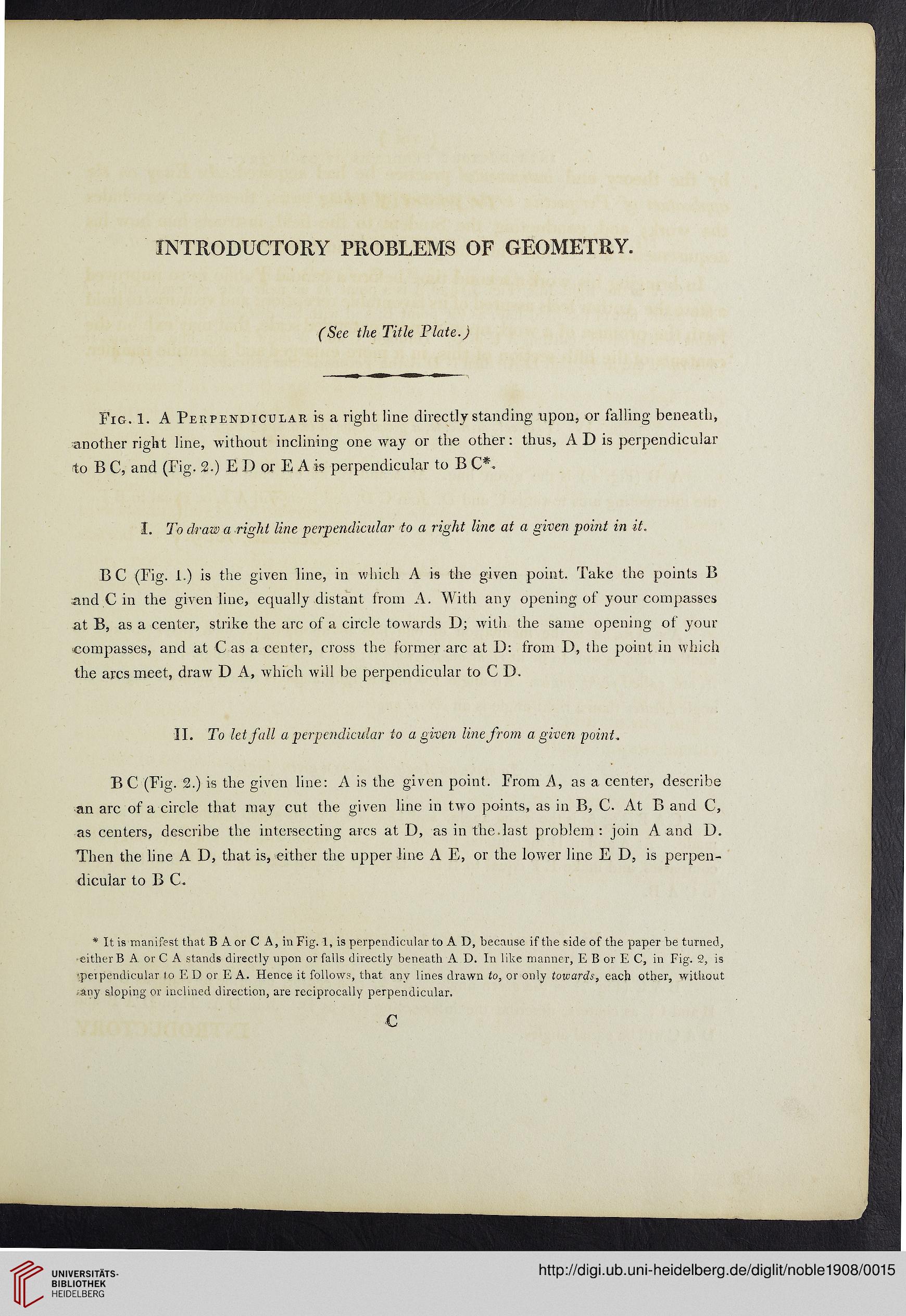INTRODUCTORY PROBLEMS OF GEOMETRY.
(See the Title Plate.)
Fig. 1. A Perpendicular is a right line directly standing upon, or falling beneath,
another right line, without inclining oneway or the other: thus, A D is perpendicular
to B C, and (Fig. 2.) E D or E A is perpendicular to B C*.
I. To draw a right line perpendicular to a right line at a given point in it.
B C (Fig. 1.) is the given line, in which A is the given point. Take the points B
and C in the given line, equally distant from A. With any opening of your compasses
at B, as a center, strike the arc of a circle towards D; with the same opening of your
compasses, and at C as a center, cross the former arc at D: from D, the point in which
the arcs meet, draw D A, which will be perpendicular to C D.
IL To let fall a perpendicular to a given line from a given point.
BC (Fig. 2.) is the given line: A is the given point. From A, as a center, describe
an arc of a circle that may cut the given line in two points, as in B, C. At B and C,
as centers, describe the intersecting arcs at D, as in the.last problem : join A and D.
Then the line A D, that is, either the upper line A E, or the lower line E D, is perpen-
dicular to B C.
* It is manifest that B A or C A, in Fig. 1, is perpendicular to A D, because if the side of the paper be turned,
either B A or C A stands directly upon or falls directly beneath A D. In like manner, E B or E C, in Fig. 2, is
•perpendicular to E D or E A. Hence it follows, that any lines drawn to, or only towards, each other, without
-any sloping or inclined direction, are reciprocally perpendicular.
(See the Title Plate.)
Fig. 1. A Perpendicular is a right line directly standing upon, or falling beneath,
another right line, without inclining oneway or the other: thus, A D is perpendicular
to B C, and (Fig. 2.) E D or E A is perpendicular to B C*.
I. To draw a right line perpendicular to a right line at a given point in it.
B C (Fig. 1.) is the given line, in which A is the given point. Take the points B
and C in the given line, equally distant from A. With any opening of your compasses
at B, as a center, strike the arc of a circle towards D; with the same opening of your
compasses, and at C as a center, cross the former arc at D: from D, the point in which
the arcs meet, draw D A, which will be perpendicular to C D.
IL To let fall a perpendicular to a given line from a given point.
BC (Fig. 2.) is the given line: A is the given point. From A, as a center, describe
an arc of a circle that may cut the given line in two points, as in B, C. At B and C,
as centers, describe the intersecting arcs at D, as in the.last problem : join A and D.
Then the line A D, that is, either the upper line A E, or the lower line E D, is perpen-
dicular to B C.
* It is manifest that B A or C A, in Fig. 1, is perpendicular to A D, because if the side of the paper be turned,
either B A or C A stands directly upon or falls directly beneath A D. In like manner, E B or E C, in Fig. 2, is
•perpendicular to E D or E A. Hence it follows, that any lines drawn to, or only towards, each other, without
-any sloping or inclined direction, are reciprocally perpendicular.




